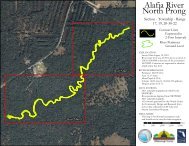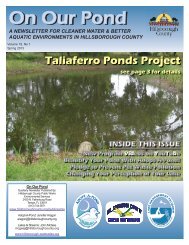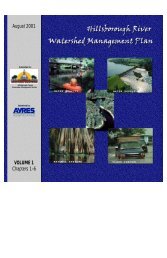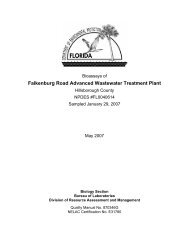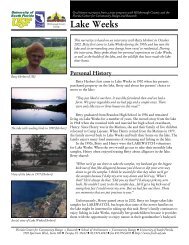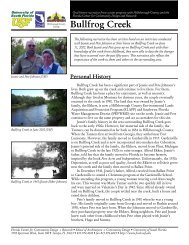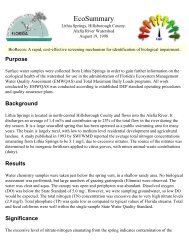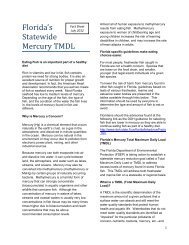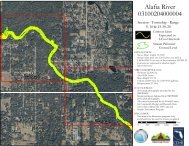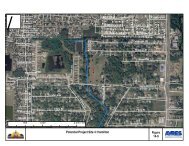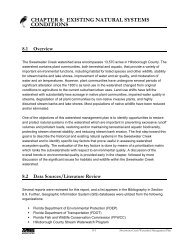Rocky Brushy Creek Watershed Mgmt. Plan (2007) -- Part 2
Rocky Brushy Creek Watershed Mgmt. Plan (2007) -- Part 2
Rocky Brushy Creek Watershed Mgmt. Plan (2007) -- Part 2
You also want an ePaper? Increase the reach of your titles
YUMPU automatically turns print PDFs into web optimized ePapers that Google loves.
EXISTING NATURAL SYSTEMS CONDITIONSAs previously discussed, the protection and preservation of the remaining natural areas of thewatershed are important components of this watershed management plan. These natural lands arecritical to the maintenance of local and regional wildlife and the protection of water resources.Approximately 35% (13,581 acres) of the watershed remains undeveloped.Strategic Conservation Habitat Areas within the <strong>Rocky</strong> <strong>Creek</strong> - <strong>Brushy</strong> <strong>Creek</strong> watershedA total of 3,112 acres (8% of the watershed) of Strategic Habitat Conservation Area (SHCA) wereidentified in the <strong>Rocky</strong>/<strong>Brushy</strong> <strong>Creek</strong> watershed. SHCA was identified for wading birds, manyspecies of which are documented as occurring in the watershed.8.5.6 Hydrologic AlterationsHydrologic alterations can be defined as any action that would change or affect the water cycle.The <strong>Rocky</strong>/<strong>Brushy</strong> <strong>Creek</strong> watershed and its diverse array of natural systems are affected byhydrological alterations that would upset the watershed’s delicate ecological balance.Development for the purposes of residential, commercial, industrial, institutional, recreational,extractive, and agricultural land use has increased impervious surface area and/or resulted in thechannelization and rerouting of surface water flows which has adversely affected the watershed’shydrological cycle.Development of groundwater supplies in the watershed has affected lake elevations and in-lakewildlife habitat. These hydrological alterations can have results such as:1. accelerated successional changes of natural systems in both upland and wetland systems;2. changes in the sizes of faunal populations (Some species are favored and increase innumbers, while others are stressed and decline in numbers and/or viability);3. reduced biodiversity; and4. changes in water quality.Natural plant communities, particularly uplands, have been replaced by agricultural, commercial, orresidential development, leaving parcels of smaller size and ecological value. While wetlands havedecreased somewhat in areal coverage, the habitat quality of existing systems can be presumed tobe less than original conditions due to several factors, including: exotic species invasion, excessivedisturbance of wetland margins, elimination of protective upland buffers; trash disposal; rimditching; and reduced hydroperiod. The elimination and disturbance of natural habitats has resultedin a decline in the number of wild animal species (lowered biodiversity) present in the watershed.8-30<strong>Rocky</strong>/<strong>Brushy</strong> <strong>Creek</strong> <strong>Watershed</strong> Management <strong>Plan</strong>



